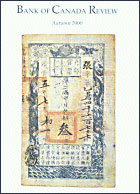November 16, 2000
Credit Derivatives
Credit derivatives are a useful tool for lenders who want to reduce their exposure to a particular borrower but are unwilling to sell their claims on that borrower. Without actually transferring ownership of the underlying assets, these contracts transfer risk from one counterparty to another. Commercial banks are the major participants in this growing market, using these transactions to diversify their portfolios of loans and other risky assets.
The authors examine the size and workings of this relatively new market and discuss the potential of these transactions for distorting existing incentives for risk management and risk monitoring.
